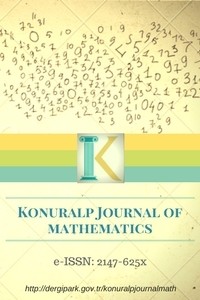COSINE ENTROPY AND SIMILARITY MEASURES FOR FUZZY SETS
COSINE ENTROPY AND SIMILARITY MEASURES FOR FUZZY SETS
entropy, fuzzy sets, fuzzy entropy fuzzy similarity,
___
- [1] D. Bhandari and N.R. Pal, Some new information measures for fuzzy sets, Information Sci- ences Vol: 67, No.2 (1993), 204-228.
- [2] S.M. Chen, S.M. Yeh and P.H. Hsiao, A comparison of similarity measures of fuzzy values, Fuzzy Sets and Systems, Fuzzy Sets and Systems Vol: 72, No.1 (1995), 79-89.
- [3] A. De Luca and S. Termini, A de nition of non-probabilistic entropy in the setting of fuzzy set theory, Information and Control Vol: 20, No.4 (1972), 301-312.
- [4] J. Fan and W. Xie, Some notes on similarity measure and proximity measure, Fuzzy Sets and Systems Vol: 101, No.3 (1999), 403-412.
- [5] Kaufmann,A., Introduction to the Theory of Fuzzy Subsets, Academic Press, New York, 1975.
- [6] X. Liu, Entropy, distance measure and similarity measure of fuzzy sets and their relations, Fuzzy Sets and Systems Vol: 52, No.3 (1992), 305-318.
- [7] N.R. Pal and S.K. Pal, Object background segmentation using new de nitions of IEEE Pro- ceedings E- Computers and Digital Techniques Vol: 366,(1989), 284-318.
- [8] C.P. Pappis and N.I. Karacapilidis, A comparative assessment of measures of similarity of fuzzy values, Fuzzy Sets and Systems Vol: 56, No.2 (1993), 171-174.
- [9] O. Prakash, P.K. Sharma and R. Mahajan, New measures of weighted fuzzy entropy and their applications for the study of maximum weighted fuzzy entropy principle, Information Sciences Vol: 178, No.11 (2008), 2839-2395.
- [10] C.E. Shannon, A mathematical theory of communication, Bell System Technical Journal Vol: 27, (1948), 379-423,623-656.
- [11] G. Salton and M.J. McGrill, Introduction to Modern Information Retrieval, McGraw {Hill Book Company, New York, (1983).
- [12] R. Verma and B.D. Sharma, On generalized exponential fuzzy entropy, World Academy of Science, Engineering and Technology Vol: 60, (2011), 1402-1405.
- [13] Wang, P.Z., Theory of Fuzzy Sets and their Applications, Shanghai Science and Technology Publishing House, Shanghai, 1982.
- [14] W.J. Wang, New similarity measures on fuzzy sets and on elements, Fuzzy Sets Systems Vol: 85, No.3 (1997), 305-309.
- [15] R.R. Yager, On the measure of fuzziness and negation Part-I membership degree in the unit interval, International Journal of General Systems Vol: 5, No.4 (1979), 221-229.
- [16] R.R. Yager, Entropy and speci city in a mathematical theory of evidence, International Journal of General Systems Vol: 9, No.4 (1983), 249-260.
- [17] R.R. Yager, Measures of entropy and fuzziness related to aggregation operators, Information Sciences Vol: 82, No.3-4 (1983), 147-166.
- [18] R.R. Yager, On the entropy of fuzzy measures, IEEE Transactions on Fuzzy Systems Vol: 8, No.4 (2000), 453-461.
- [19] L.A. Zadeh, Fuzzy Sets, Information and Control Vol: 8, No.3 (1965), 338-353.
- [20] L.A. Zadeh, Probability measure of fuzzy events, Journal of Mathematical Analysis and Applications Vol: 23, No.2 (1968), 421-427.
- [21] R. Zwick, E. Carlstein and D.V. Budesco, Measures of similarity amongst fuzzy concepts: A comparative analysis, International Journal of Approximate Reasoning Vol: 1, No.2 (1987), 221-242.
- Yayın Aralığı: Yılda 2 Sayı
- Başlangıç: 2013
- Yayıncı: Mehmet Zeki SARIKAYA
ON A NEW CLASS OF s-TYPE OPERATORS
Emrah Evren KARA, Merve İLKHAN
REFINEMENT OF SOME INEQUALITIES FOR OPERATORS
COSINE ENTROPY AND SIMILARITY MEASURES FOR FUZZY SETS
EMBEDDING THE COMPLEMENT OF A COMPLETE GRAPH IN A FINITE PROJECTIVE PLANE
OSTROWSKI TYPE INEQUALITIES FOR HARMONICALLY s-CONVEX FUNCTIONS
